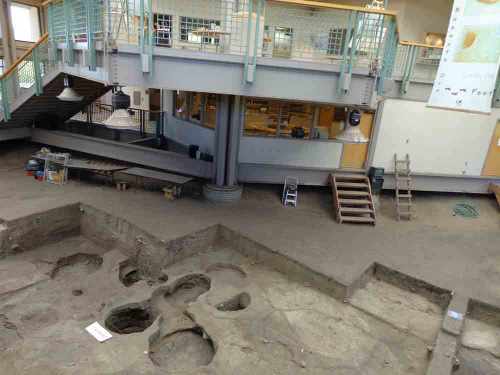Despite the fact that this is a National Historic Landmark, you may discover that your GPS can’t get you to this place. Fortunately, if you just drive north on Main St. a couple of miles from the Corn Palace, you’ll see a sign at 23rd Avenue (left turn if you’re heading north), and that will at least direct you to the right road: Indian Village Road. Turn right at Indian Village Road and drive until you see a parking lot on the right, with a few signs suggesting that something is nearby.
Hike down the hill, past information signs with Native American symbols and some very interesting information, cross a little bridge over an inlet of lovely Lake Mitchell, and follow the path up the low hill on the far side. This will bring you to the Prehistoric Indian Village Museum. It’s worth the small effort required to find the place.
What you will reach first is the museum, where you will be introduced to the culture of the people who inhabited this point of land around AD 900–1000. There is a short, excellent movie on the people who once inhabited this area, followed by a docent-led tour, and then you can explore on your own. It is not a large museum, but the exhibits are rich with artifacts and information. Roughly 1.5 million artifacts have been found at this site, and many of them are on display in the museum. A full-size reconstructed lodge, like the ones that housed the original inhabitants, offers insight into what living conditions were like.

Wood poles make up the roof of the lodge, and it was these that eventually required that the people move. There is very little wood on the Great Plains, so after about 100 years, there was no source of wood left, so the people migrated northward. It is thought that they were the ancestors of the Mandan, people who hosted Lewis and Clark when they arrived a few hundred years later.
Abundant maps and signs help establish where people settled and how they moved around, where languages originated, and what trade goods passed through.

The people who lived here were part of a vast trading network. The patterns on the pottery can be traced to Cahokia in Illinois. Only broken pots have been found, however, because they would have taken unbroken pots with them when they moved.
The trade good that was produced here appears to have been pemmican, a handy “energy bar” made of dried meat (generally bison), dried berries, and fat, that was great for travel or to get through a rough winter. The evidence that suggests this as an important trade good includes a disproportionately large number of broken buffalo bones—far more than could be consumed by the people in the village—along with equipment and supplies that would be used in creating pemmican.

Evidence of pemmican making
Corn had come north with these people, as well as squash and beans, and these were in evidence in the exhibit, as were tools used in farming these crops. A hoe made of the shoulder blade of a bison and a rake made of deer antlers were propped up near the lodge, and it struck me that they looked remarkably like tools used in so many other parts of the world, both then and now.
Lots more to learn and see, but I figure I had better leave something for you to discover on your own. Off next to the Archeodome, across the broad, green lawns that border Mitchell Lake.






























